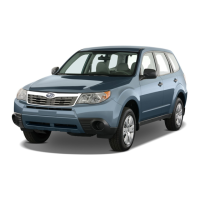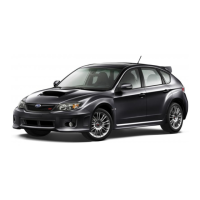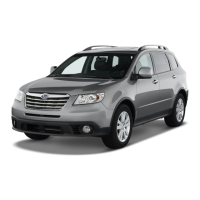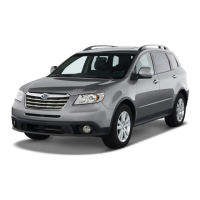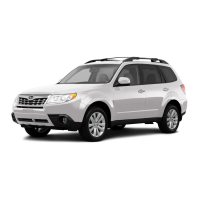Do you have a question about the Subaru 2010 FORESTER and is the answer not in the manual?
Details on warranties provided for Subaru vehicles sold in the United States, including Limited Warranty and Emission Control Systems Warranty.
Details on warranties provided for Subaru vehicles sold in Canada, including Limited Warranty and Anti-Corrosion Warranty.
Guidance on how to effectively read and use the owner's manual for vehicle operation and safety.
Information on using seats, seatbelts, and SRS airbags, including safety precautions.
Instructions on operating vehicle keys, locks, and windows for security and convenience.
Details on the operation of instrument panel indicators and various vehicle switches.
Essential safety advice on using seatbelts and understanding SRS airbags for occupant protection.
Guidelines and warnings for safely restraining children in the vehicle, including child seat usage.
Information on the dangers of engine exhaust gas and precautions to prevent exposure.
Critical warnings against driving under the influence of alcohol to prevent accidents and injury.
Precautions regarding driving after taking medications that may impair ability or using illicit drugs.
Safety advice on recognizing and avoiding the risks associated with driving while fatigued.
Recommendations for safely restraining pets in the vehicle to prevent distractions and injuries.
Guidance on using hazard warning flashers and safe procedures for parking in emergency situations.
Steps for safely changing a flat tire, including warnings about vehicle jacking and tool usage.
Instructions and safety warnings for jump starting a vehicle with a discharged battery.
Procedures for handling an overheated engine, including safety checks for steam and coolant.
Overview of recommended maintenance intervals and services for optimal vehicle condition.
Important safety guidelines and precautions to follow when performing vehicle maintenance.
Instructions on how to safely open and close the vehicle's engine hood, including warnings.
Guidance on checking engine oil level, recommended grades, and procedures for changing oil and filter.
Information on the cooling system, including fan operation, hoses, connections, and coolant.
Instructions for replacing the air cleaner element, with warnings and cautions for proper installation.
Recommendations for spark plug replacement and precautions to ensure correct installation.
Information on drive belts, including inspection and deflection checks for proper operation.
Procedures for checking and recommended grade/viscosity for manual transmission oil.
Guidance on checking and recommended types of automatic transmission fluid for vehicle performance.
Procedures for checking and recommended grade/viscosity for front differential gear oil.
Instructions for checking and recommended grade/viscosity for rear differential gear oil.
Guidance on checking power steering fluid level and recommended fluid types.
Procedures for checking brake fluid level and recommended fluid types, with safety precautions.
Instructions for checking clutch fluid level and recommended fluid types, with safety precautions.
Information on brake booster operation and checks, including symptoms of malfunction.
Checking brake pedal free play and reserve distance according to maintenance schedule.
Ensuring the Hill start assist system operates correctly for starting on uphill grades.
Information on replacing brake pads and linings, including wear indicators and break-in procedures.
Details on tire types, inspection, pressure, wear, balance, rotation, and replacement.
Explanation of the TPMS, its warning light, and procedures for checking tire pressure.
Key exterior dimensions of the vehicle, including length, width, height, wheelbase, and ground clearance.
Technical specifications for the vehicle's engine, including model, type, displacement, and firing order.
Details on the vehicle's electrical system, including battery, alternator, and spark plug specifications.
Fluid capacities for the vehicle, including fuel tank, engine oil, transmission fluid, and coolant.
Specifications for tire sizes, wheel sizes, pressures, and temporary spare tire details.
Specifications for wheel alignment parameters such as toe and camber for front and rear wheels.
Location and rating of fuses for the passenger compartment and engine compartment fuse panels.
Diagram and list of fuses for the passenger compartment fuse panel and their corresponding circuits.
Diagram and list of fuses for the engine compartment fuse panel and their corresponding circuits.
Chart detailing bulb types, wattage, and bulb numbers for various exterior and interior lights.
Information on vehicle identification labels and their locations for VIN, emission, and tire pressure.
Information compiled according to Code of Federal Regulations Title 49, Part 575.
Details on tire labeling, including tire size, load index, speed rating, and construction type.
Recommended cold tire inflation pressures for various tire sizes and conditions, including towing.
Definitions of common tire terms such as bead, chunking, cord, tread, and rim.
Daily checks for tire damage, inspection of tread, and importance of tire rotation for longevity.
Explanation of how to determine vehicle load capacity, including occupant and cargo weight limits.
Ensuring tire load ratings exceed vehicle's maximum load for safe operation.
How overloading affects vehicle handling, stopping distance, tires, and the risk of accidents.
Step-by-step guide to calculate the correct load limit for the vehicle based on placard information.
Explanation of UTQG standards for treadwear, traction, and temperature resistance.
Information on treadwear grades as a comparative rating based on tire wear rate.
Explanation of traction grades representing the tire's ability to stop on wet pavement.
Explanation of temperature grades representing tire resistance to heat generation and dissipation.
Procedure for reporting vehicle defects to NHTSA and Subaru of America, Inc.
Details on warranties provided for Subaru vehicles sold in the United States, including Limited Warranty and Emission Control Systems Warranty.
Details on warranties provided for Subaru vehicles sold in Canada, including Limited Warranty and Anti-Corrosion Warranty.
Guidance on how to effectively read and use the owner's manual for vehicle operation and safety.
Information on using seats, seatbelts, and SRS airbags, including safety precautions.
Instructions on operating vehicle keys, locks, and windows for security and convenience.
Details on the operation of instrument panel indicators and various vehicle switches.
Essential safety advice on using seatbelts and understanding SRS airbags for occupant protection.
Guidelines and warnings for safely restraining children in the vehicle, including child seat usage.
Information on the dangers of engine exhaust gas and precautions to prevent exposure.
Critical warnings against driving under the influence of alcohol to prevent accidents and injury.
Precautions regarding driving after taking medications that may impair ability or using illicit drugs.
Safety advice on recognizing and avoiding the risks associated with driving while fatigued.
Recommendations for safely restraining pets in the vehicle to prevent distractions and injuries.
Guidance on using hazard warning flashers and safe procedures for parking in emergency situations.
Steps for safely changing a flat tire, including warnings about vehicle jacking and tool usage.
Instructions and safety warnings for jump starting a vehicle with a discharged battery.
Procedures for handling an overheated engine, including safety checks for steam and coolant.
Overview of recommended maintenance intervals and services for optimal vehicle condition.
Important safety guidelines and precautions to follow when performing vehicle maintenance.
Instructions on how to safely open and close the vehicle's engine hood, including warnings.
Guidance on checking engine oil level, recommended grades, and procedures for changing oil and filter.
Information on the cooling system, including fan operation, hoses, connections, and coolant.
Instructions for replacing the air cleaner element, with warnings and cautions for proper installation.
Recommendations for spark plug replacement and precautions to ensure correct installation.
Information on drive belts, including inspection and deflection checks for proper operation.
Procedures for checking and recommended grade/viscosity for manual transmission oil.
Guidance on checking and recommended types of automatic transmission fluid for vehicle performance.
Procedures for checking and recommended grade/viscosity for front differential gear oil.
Instructions for checking and recommended grade/viscosity for rear differential gear oil.
Guidance on checking power steering fluid level and recommended fluid types.
Procedures for checking brake fluid level and recommended fluid types, with safety precautions.
Instructions for checking clutch fluid level and recommended fluid types, with safety precautions.
Information on brake booster operation and checks, including symptoms of malfunction.
Checking brake pedal free play and reserve distance according to maintenance schedule.
Ensuring the Hill start assist system operates correctly for starting on uphill grades.
Information on replacing brake pads and linings, including wear indicators and break-in procedures.
Details on tire types, inspection, pressure, wear, balance, rotation, and replacement.
Explanation of the TPMS, its warning light, and procedures for checking tire pressure.
Key exterior dimensions of the vehicle, including length, width, height, wheelbase, and ground clearance.
Technical specifications for the vehicle's engine, including model, type, displacement, and firing order.
Details on the vehicle's electrical system, including battery, alternator, and spark plug specifications.
Fluid capacities for the vehicle, including fuel tank, engine oil, transmission fluid, and coolant.
Specifications for tire sizes, wheel sizes, pressures, and temporary spare tire details.
Specifications for wheel alignment parameters such as toe and camber for front and rear wheels.
Location and rating of fuses for the passenger compartment and engine compartment fuse panels.
Diagram and list of fuses for the passenger compartment fuse panel and their corresponding circuits.
Diagram and list of fuses for the engine compartment fuse panel and their corresponding circuits.
Chart detailing bulb types, wattage, and bulb numbers for various exterior and interior lights.
Information on vehicle identification labels and their locations for VIN, emission, and tire pressure.
Information compiled according to Code of Federal Regulations Title 49, Part 575.
Details on tire labeling, including tire size, load index, speed rating, and construction type.
Recommended cold tire inflation pressures for various tire sizes and conditions, including towing.
Definitions of common tire terms such as bead, chunking, cord, tread, and rim.
Daily checks for tire damage, inspection of tread, and importance of tire rotation for longevity.
Explanation of how to determine vehicle load capacity, including occupant and cargo weight limits.
Ensuring tire load ratings exceed vehicle's maximum load for safe operation.
How overloading affects vehicle handling, stopping distance, tires, and the risk of accidents.
Step-by-step guide to calculate the correct load limit for the vehicle based on placard information.
Explanation of UTQG standards for treadwear, traction, and temperature resistance.
Information on treadwear grades as a comparative rating based on tire wear rate.
Explanation of traction grades representing the tire's ability to stop on wet pavement.
Explanation of temperature grades representing tire resistance to heat generation and dissipation.
Procedure for reporting vehicle defects to NHTSA and Subaru of America, Inc.
| Brand | Subaru |
|---|---|
| Model | 2010 FORESTER |
| Category | Automobile |
| Language | English |
